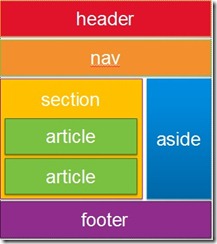📖 HTML5
HTML5 is the new standard for HTML. The previous version of HTML came in 1999. The web has changed a lot since then. HTML5 is still a work in progress. However, most modern browsers have some HTML5 support.
Learn more about HTML5 Semantic Tags at the W3 Schools.
HTML5 Development Rules
- New features should be based on HTML, CSS, DOM, and JavaScript
- Reduce the need for external plugins (like Flash)
- Better error handling
- More markup to replace scripting
- HTML5 should be device independent
- The development process should be visible to the public
New Features of HTML5
- New content specific elements, like article, footer, header, nav, section
- New form controls, like calendar, date, time, email, url, search
- The video and audio elements for media playback
- The canvas element for drawing
- Better support for local offline storage
HTML5 DOCTYPE and charset
<!DOCTYPE HTML><html lang="en"><meta charset="UTF-8">
Obsolete Elements
- frameset, frame and noframes
- acronym
- presentational elements such as font, big, center and strike
- presentation attributes such as bgcolor, align, cellspacing, cellpadding
Elements That Have Changed
- small
- now means 'the small print' not small text size
- b
- is now 'stylistically offset this from the text around it', not bold
- i
- means 'in an alternate voice or mood', not italicize
- cite
- now is the title of a work
- a
- element may now be wrapped around multiple block elements
HTML5 Semantic Elements
HTML5 has added several new semantic elements that help structure your page.
- provide a new way for browsers to understand your content
- works as a kind of outlining tool for your site
- may be helpful with SEO and accessibility (in the future if not yet)
- not all elements supported by all browsers
- included here are those supported by most major browsers
Semantic Block Elements
<section></section>
- is used for content that can be grouped thematically.
- all content contained by
<section>is related</section> - should not be used just for styles (stick with a
<div>tag</div>for that) - indicates major topics for outlining
<header></header>
- typically contains the headline or grouping of headlines for a page
- may also contain other supplemental information like logos and navigational aids
- may also be used within a section
<footer></footer>
- used for content about a page, such as who wrote it, links to related information and copyrights.
<nav></nav>
- used to contain major navigation links for a page
- often included in
for the page
<article></article>
- used for content that is self-contained and could be consumed independent of the page as a whole, such as a blog entry
- An article should make sense on its own and it should be possible to distribute it independently from the rest of the site.
Examples of Articles
- forum post
- newspaper article
- blog entry
- user comment
<aside></aside>
- a portion of a page that is related to the content around it, but also separate from that content, such as a sidebar or pull-quotes.
- if you can remove the content without affecting understanding of the page, use
<aside></aside> - typically formatted as a sidebar
<address></address>
- holds contact information for the author of a page or section
- often displayed in italics
Semantic Inline Elements
<figure></figure>
- specifies self-contained flow content such as images or code
- content should be relevant to the main content, but if removed, should not affect the flow of the document.
<figcaption></figcaption>
- contains a caption for the
<figure>tag</figure> - should be first or last element in
<figure>tag</figure>
<mark></mark>
- defines marked text
- use for text you want to be highlighted
Sample HTML5 Layout and Code

